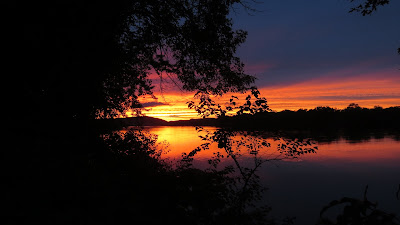This appeared in the SP Star about this time last year. This still is pretty much true this year.
Since August we've began to see changes in the world of nature. I'm
sure many of you have noticed that the summer birds are moving south.
Locally, I haven't seen any rose-breasted grosbeaks in a few
weeks. The migration to their winter home has brought an increase in the numbers
of Baltimore orioles (the orioles came through earlier this year, 2016) and ruby-throated
hummingbirds to the syrup feeders. There
have been palm and yellow warblers in the birdbath just outside
the living room window. One late afternoon a pair of young redstarts
paid a
visit to the birdbath, I don't recall ever having them in my yard before.
At
this time, the regular summer birds such as chipping sparrows,
goldfinches, and chickadees
are losing their territorial instincts and
are gathering in small flocks. Nuthatches, titmice, and pine siskins, which
we'll see all winter, are appearing daily. It will be awhile, but when we start
seeing juncos, we'll know we're passed the point of no
return.
Out on the river the young Canada geese and mallard ducks
are as large as their parents. The water levels have been low enough for the
shore birds such as sandpipers, killdeer and blue
herons,
to spend time pecking out some tasty morsels (maybe a mussel now and then). I
hadn't seen any bald eagles for some time
but twice, recently, I've
disturbed one perched just to the right of my deck. The quality of the water in
the river been has great for swimming
this summer but soon the weather will bring
it to an end for this year.
I recently witnessed a seldom seen migration in this
area. Mid-morning a couple of weeks ago there was a large turtle making
its way
across Hwy Y. It appeared to be leaving the
wetland area that may now be dry from the
lack of mid-summer rain. It was headed toward the river. It had an unusual
appearance – probably nine inches around
and had a helmet-shaped shell. I stopped and made sure it didn't get run over.
It's sad, but I have seen turtles that didn't make it. It isn't as
if they jump out in front of a moving car. I wish I would have had my camera
with me. After doing some research I believe it may have been a Blanding’s turtle,
which was just recently removed from the threatened list in Wisconsin. We'll
never know for sure.
If you’re lucky enough to see one of this year’s white-tailed deer
fawns,
the white spots should be gone. When you have time, check ponds for
migrating ducks. I've seen a couple of
small flocks flying over the river – I couldn't identify them but could tell they weren't mallards by the
distinctive movement of their wings in flight. There have been reports of
blue-winged teal in the area. Some young squirrels still haven't figured out how
to bite off twigs and hold on to them at the same time (nest building
101), although my flower pots indicate that they know what to do with
the abundance of acorns this year.
 If you see a monarch butterfly in the next few weeks it
may be one of this year’s fourth generation. This season’s mating has come to
an end and these delicate creatures have the task of flying to California or
Mexico. There they will hibernate until something in them awakens their drive to
head back north and begin the life cycle once again.
If you see a monarch butterfly in the next few weeks it
may be one of this year’s fourth generation. This season’s mating has come to
an end and these delicate creatures have the task of flying to California or
Mexico. There they will hibernate until something in them awakens their drive to
head back north and begin the life cycle once again.
With the cooler weather of the past couple of weeks, the Virginia
creeper has started to turn red. In the prairies, some native
flowers are beginning to fade but the grasses are tall and waving their bronze
seed-heads in the breeze. In my small prairie I have several big bluestem grass plants
that are seven feet tall. I got this photo of a native field thistle along Hwy
Y. All thistles have a bad reputation but you can't tell me it
isn’t a beauty of nature.

As always,
keep watching – nature has
something special for us around every corner.












